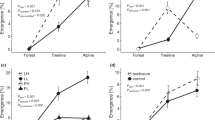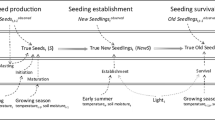Abstract
Climate change will cause large-scale plant migration. Seedling recruitment constitutes a bottleneck in the migration process but is itself climate-dependent. We tested the effect of warming on early establishment of three Arctic pioneer species, while holding other environmental variables constant. Seeds and bulbils were sown in artificial gaps in dry Arctic tundra and subjected to a 13-day heating of the soil surface by 2–8°C, simulating temperature increases ranging from the general summer warming to heat waves projected to occur more frequently with global warming. All species showed decreased establishment with increasing soil surface temperature. The short-term heat pulse decreased establishment of Polygonum viviparum and Saxifraga cernua, whereas establishment of Cerastium alpinum decreased with temperature due to more permanent natural variation in micro-climate. The treatment effects increased by the quadrat of the temperature increase. Warming and in particular heat waves may result in declining establishment of Arctic plants in dry tundra regions.



Similar content being viewed by others
References
Aerts R, Cornelissen JHC, Dorrepaal E (2006) Plant performance in a warmer world: general responses of plants from cold, northern biomes and the importance of winter and spring events. Plant Ecol 182:65–77. doi:10.1007/s11258-005-9031-1
Anon (2002) S-PLUS 6.1 for Windows. Professional Edition. Insightful Corp., Seattle
Arft AM, Walker MD, Gurevitch J, Alatalo JM, Bret-Harte MS, Dale M, Diemer M, Gugerli F, Henry GHR, Jones MH, Hollister RD, Jonsdottir IS, Laine K, Levesque E, Marion GM, Molau U, Molgaard P, Nordenhall U, Raszhivin V, Robinson CH, Starr G, Stenstrom A, Stenstrom M, Totland O, Turner PL, Walker LJ, Webber PJ, Welker JM, Wookey PA (1999) Responses of tundra plants to experimental warming: Meta-analysis of the international tundra experiment. Ecol Monogr 69:491–511. doi:10.1890/0012-9615(1999)069[0491:ROTPTE]2.0.CO;2
Baskin CC, Baskin JM (1998) Seeds, ecology, biogepgraphy, and evolution of dormancy and germination. Academic Press, London
Bell KL, Bliss C (1980) Plant reproduction in a high arctic environment. Arct Alp Res 12:1–10. doi:10.2307/1550585
Bliss LC, Gold WG (1999) Vascular plant reproduction, establishment, and growth and the effects of cryptogamic crusts within a polar desert ecosystem, Devon Island, NWT, Canada. Can J Bot 77:623–636. doi:10.1139/cjb-77-5-623
Cavieres LA, Badano EI, Sierra-Almeida A, Gómez-González S, Molina-Montenegro MA (2006) Positive interactions between alpine plant species and the nurse cushion plant Larentia acaulis do not increase with elevation in the Andes of central Chile. New Phytol 169:59–69. doi:10.1111/j.1469-8137.2005.01573.x
Cavieres LA, Badano EI, Sierra-Almeida A, Molina-Montenegro M (2007) Microclimatic modifications of cushion plants and their consequences for seedling survival of native and non-native herbaceous species in the high Andes of central Chile. Arct Antarct Alp Res 39:229–236. doi:10.1657/1523-0430(2007)39[229:MMOCPA]2.0.CO;2
Cavieres LA, Quiroz CL, Molina-Montenegro MA (2008) Facilitation of the non-native Taraxacum officinale by native cushion species in the high Andes of central Chile: are there differences between nurses. Funct Ecol 22:148–156. doi:10.1111/j.1365-2435.2008.01382.x
Chambers JC (1995a) Disturbance, life-history strategies, and seed fates in Alpine Herbfield communities. Am J Bot 82:421–433. doi:10.2307/2445588
Chambers JC (1995b) Relationships between seed fates and seedling establishment in an Alpine ecosystem. Ecology 76:2124–2133. doi:10.2307/1941687
Chambers JC, MacMahon JA, Brown RW (1990) Alpine seedling establishment—the influence of disturbance type. Ecology 71:1323–1341. doi:10.2307/1938270
Christensen JH, Hewitson B, Busuioc A, Chen A, Gao X, Held I, Jones RK, Kolli RK, Kwon W-T, Laprise R, Magaña Rueda V, Mearns L, Menéndez CG, Räisånen J, Rinke A, Sarr A, Whetton P (2007) Regional Climate Projections. In: Solomon S, Qin D, Manning M, Chen Z, Marquis M, Averyt KB, Tignor M, Miller HL (eds) Climate change 2007: the physical science basis. Contribution of Working Group I to the fourth assessment report of the Intergovernmental Panel on Climate Change. Cambridge University Press, New York
Cooper EJ, Alsos IG, Hagen D, Smith FM, Coulson SJ, Hodkinson ID (2004) Plant recruitment in the High Arctic: seed bank and seedling emergence on Svalbard. J Veg Sci 15:115–124. doi:10.1658/1100-9233(2004)015[0115:PRITHA]2.0.CO;2
Cuevas j (2000) Tree recruitment at the Nothofagus pumilio alpine timberline in Tierra del Fuego, Chile. J Ecol 88:840–855
Diemer M (2002) Population stasis in a high-elevation herbaceous plant under moderate climate warming. Basic Appl Ecol 3:77–83. doi:10.1078/1439-1791-00079
Dona AJ, Galen C (2006) Sources of spatial and temporal heterogeneity in the colonization of an alpine krummholz environment by the weedy subalpine plant Chamerion angustifolium (fireweed). Can J Bot 84:933–939. doi:10.1139/B06-048
Forbis TA (2003) Seedling demography in an alpine ecosystem. Am J Bot 90:1197–1206. doi:10.3732/ajb.90.8.1197
Germino MJ, Smith WK, Resor AC (2002) Conifer seedling distribution and survival in an alpine-treeline ecotone. Plant Ecol 162:157–168. doi:10.1023/A:1020385320738
Gough L (2006) Neighbor effects on germination, survival, and growth in two arctic tundra plant communities. Ecography 29:44–56. doi:10.1111/j.2005.0906-7590.04096.x
Graae BJ, Pagh S, Bruun HH (2004) An experimental evaluation of the arctic fox (Alopex lagopus) as a seed disperser. Arct Antarct Alp Res 36:468–473. doi:10.1657/1523-0430(2004)036[0468:AEEOTA]2.0.CO;2
Graae BJ, Alsos IG, Ejrnaes R (2008) Germination of Vaccinium uliginosum and Empetrum nigrum from different climates. Plant Ecol 198:275–284. doi:10.1007/s11258-008-9403-4
Hobbie SE, Chapin FS (1998) An experimental test of limits to tree establishment in Arctic tundra. J Ecol 86:449–461. doi:10.1046/j.1365-2745.1998.00278.x
Humlum O (2000) The geomorphic significance of rock glaciers: estimates of rock glacier debris volumes and headwall recession rates in West Greenland. Geomorphol 35:41–67. doi:10.1016/S0169-555X(00)00022-2
Ibanez I, Clark JS, LaDeau S, HilleRisLambers J (2007) Exploiting temporal variability to understand tree recruitment response to climate change. Ecol Monogr 77:163–177. doi:10.1890/06-1097
Jeltsch F, Moloney KA, Schurr FM, Köchy M, Schwager M (2008) The state of plant population modelling in light of environmental change. Perspect Plant Ecol Evol Syst 9:171–189. doi:10.1016/j.ppees.2007.11.004
Kimball BA (2005) Theory and performance of an infrared heater for ecosystem warming. Glob Change Biol 11:2041–2056. doi:10.1111/j.1365-2486.2005.1028.x
Klanderud K, Totland O (2007) The relative role of dispersal and local interactions for alpine plant community diversity under simulated climate warming. Oikos 116:1279–1288. doi:10.1111/j.0030-1299.2007.15906.x
Körner C (2003) Alpine Plant Life. Functional Plant Ecology of High Mountain Ecosystems. Springer, Heidelberg
Körner C (2007) The use of ‘altitude’ in ecological research. Trends Ecol Evol 22:569–574. doi:10.1016/j.tree.2007.09.006
Lambrecht S, Loik M, Inouye D, Harte J (2006) Reproductive and physiological responses to simulated climate warming for four subalpine species. New Phytol 173:121–134. doi:10.1111/j.1469-8137.2006.01892.x
Lindgren Å, Eriksson O, Moen J (2007) The impact of disturbance and seed availability on germination of alpine vegetation in the Scandinavian mountains. Arct Antarct Alp Res 39:449–454. doi:10.1657/1523-0430(06-024)[LINDGREN]2.0.CO;2
Maher EL, Germino MJ, Hasselquist NJ (2005) Interactive effects of tree and herb cover on survivorship, physiology, and microclimate of conifer seedlings at the alpine tree-line ecotone. Can J For Res 35:567–574. doi:10.1139/x04-201
Marchand FL, Verlinden M, Kockelbergh F, Graae BJ, Beyens L, Nijs I (2006) Disentangling effects of an experimentally imposed extreme temperature event and naturally associated desiccation on Arctic tundra. Funct Ecol 20:917–928. doi:10.1111/j.1365-2435.2006.01203.x
Molau U (1997) Age-related growth and reproduction in Diapensia lapponica, an arctic-alpine cushion plant. Nord J Bot 17:225–234. doi:10.1111/j.1756-1051.1997.tb00314.x
Nijs I, Kockelbergh F, Heuer M, Beyens L, Trappeniers K, Impens I (2000) Climate-warming simulation in tundra: enhanced precision and repeatability with an improved infrared-heating device. Arct Antarct Alp Res 32:346–350. doi:10.2307/1552534
Pinheiro JC, Bates DM (2000) Mixed-effects models in S and S-plus. Springer, New York, 528 pp
Probert RJ (2000) The role of temperature in the regulation of seed dormancy and germination. In: Fenner M (ed) The ecology of regeneration in plant communities. CABI Publishing, Wallingford, pp 261–292
Shimono Y, Kudo G (2005) Comparisons of germination traits of alpine plants between fellfield and snowbed habitats. Ecol Res 20:189–197. doi:10.1007/s11284-004-0031-8
Svensson BM, Carlsson BÅ, Karlsson PS, Nordell KO (1993) Comparative long-term demography of three species of Pinguicula. J Ecol 81:635–645. doi:10.2307/2261662
Tape K, Sturm M, Racine C (2006) The evidence for shrub expansion in northern Alaska and the Pan-Arctic. Glob Change Biol 12:686–702. doi:10.1111/j.1365-2486.2006.01128.x
Thorn CE, Darmody RG, Allen CE, Dixon JC (2002) Near-surface ground temperature regime variability in selected microenvironments, Kärkevagge, Swedish Lapland. Geogr Ann Ser B 84:289–300. doi:10.1111/j.0435-3676.2002.00183.x
Verbyla D (2008) The greening and browning of Alaska based on 1982–2003 satellite data. Glob Ecol Biogeogr 17:547–555. doi:10.1111/j.1466-8238.2008.00396.x
Welling P, Laine K (2000) Characteristics of the seedling flora in alpine vegetation, subarctic Finland, I. Seedling densities in 15 plant communities. Ann Bot Fenn 37:69–76
Welling P, Laine K (2002) Regeneration by seeds in alpine meadow and heath vegetation in sub-arctic Finland. J Veg Sci 13:217–226. doi:10.1658/1100-9233(2002)013[0217:RBSIAM]2.0.CO;2
Wenk EH, Dawson TE (2007) Interspecific differences in seed germination, establishment, and early growth in relation to preferred soil type in an alpine community. Arct Antarct Alp Res 39:165–176. doi:10.1657/1523-0430(2007)39[165:IDISGE]2.0.CO;2
Acknowledgments
Jørgen Meisfjord is thanked for helpful suggestions regarding nonlinear mixed-effects models, Melanie Pantz for assistance in the field, and two anonymous reviewers and Angela Moles for suggesting very valuable improvements on earlier versions of the manuscript. The study was supported by a grant to BJG by The National Science Foundation in Denmark 21-02-0515 and by project G.0357.02 of the Research Foundation—Flanders. Ann Milbau holds a postdoctoral research grant and Anna Shevtsova a visiting postdoctoral fellowship from the Research Foundation—Flanders.
Author information
Authors and Affiliations
Corresponding author
Electronic supplementary material
Below is the link to the electronic supplementary material.
300_2009_608_MOESM1_ESM.tif
Supplementary material 1 Observations of seedling numbers in micro-plots along days in 2003 shown with the predictions of the NLME-model. Above each panel is indicated the modelled soil surface temperature increase from the linear mixed-effects model (Fig. 1). (TIFF 657 kb)
300_2009_608_MOESM2_ESM.eps
Supplementary material 2 Observation of number of seedlings of the three species recorded in the microplots at day 55 after warming began plottet against the manipulated temperature increase. Averages for seedling number for each temperature increase are indicated (-). (EPS 12 kb)
Rights and permissions
About this article
Cite this article
Graae, B.J., Ejrnæs, R., Marchand, F.L. et al. The effect of an early-season short-term heat pulse on plant recruitment in the Arctic. Polar Biol 32, 1117–1126 (2009). https://doi.org/10.1007/s00300-009-0608-3
Received:
Revised:
Accepted:
Published:
Issue Date:
DOI: https://doi.org/10.1007/s00300-009-0608-3




